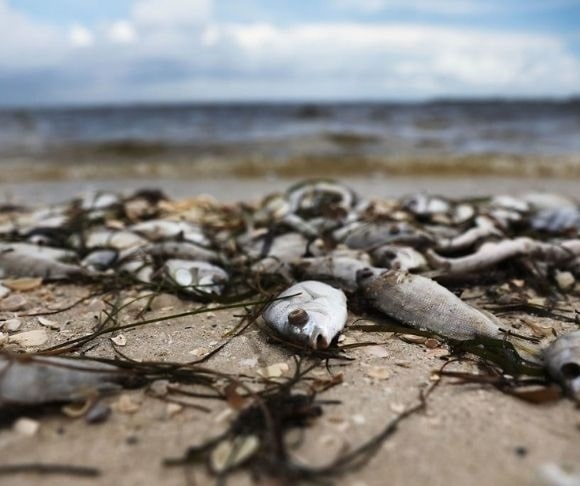“Mom, can we go to the beach?” Increasingly the answer is no for those who live and vacation in Florida’s vast Gulf Coast region. From Bonita Springs all the way up to Sarasota County, toxic red tide is rolling in, forcing beach bums back to the pool.
 Karenia brevis algae – commonly called “red tide” because its colorful blooms turn coastal water scarlet – is making its grand entrance up and down Florida’s western shoreline, and it’s not pretty. Aside from the smell of death, red tide triggers a whole host of deleterious consequences.
Karenia brevis algae – commonly called “red tide” because its colorful blooms turn coastal water scarlet – is making its grand entrance up and down Florida’s western shoreline, and it’s not pretty. Aside from the smell of death, red tide triggers a whole host of deleterious consequences.
The Tangled Red Web
Sea creatures of all manner, from fish to dolphins, die as a result of asphyxiation because the algae bloom chokes off the oxygen in the water. The toxins released by the massive algae population are troublesome for humans, as well.
People are exposed through a variety of mechanisms that include eating tainted fish, breathing in the toxins that pollute the air, and in some cases, through skin contact. It’s believed Karenia brevis can cause neurological problems and impact those with chronic respiratory ailments like emphysema. Bottom line: you really don’t want to hang out on a beach with red tide.
While the algae bloom is considered a natural phenomenon, there are certain conditions that exacerbate its growth, such as warm waters, low saline content, rain followed by sun, and calm seas. It’s primarily spread by ships, storms, currents, and the wind. And despite millions of dollars that have been poured into trying to stem growth, very few – if any – efforts to prevent the algae have paid off. In fact, the species has exploded 15-fold in the last 50 years. Its proliferation still vexes scientists and continues to pound the Gulf Coast tourist industry with no end in sight. To make matters worse, experts seem unable to predict when and where this toxic phenomenon will next hit.
No Fun in Florida
 Those who usually head to the warmer climate of Florida’s posh and trendy Gulf Coast in the winter are hedging their bets and staying home as they wait for the red tide to recede. Thus, this major ecosystem malfunction has cost the state of Florida millions both in terms of trying to halt its unwanted appearance and in lost tourism. Last year was historically bad, and the hope was that this year, it would not be as widespread – but that optimism appears to be fading as the deadly algae makes its way up the coast, headed for Tampa Bay.
Those who usually head to the warmer climate of Florida’s posh and trendy Gulf Coast in the winter are hedging their bets and staying home as they wait for the red tide to recede. Thus, this major ecosystem malfunction has cost the state of Florida millions both in terms of trying to halt its unwanted appearance and in lost tourism. Last year was historically bad, and the hope was that this year, it would not be as widespread – but that optimism appears to be fading as the deadly algae makes its way up the coast, headed for Tampa Bay.
Those who hold to the climate change theory like to claim red tide as a side effect of what they believe to be the warming of the earth, but so far scientists have been unable to make that connection. Karenia brevis appears to be a mystery that marine experts haven’t yet been able to unravel. Meanwhile, the carcasses of sea life are beginning to wash up on beaches like waterlogged roadkill. Between the stench of the dead and the algae‘s own noxious odor, the Gulf Coast of Florida is not a happening place. And that’s a sad tale indeed for those hoping to escape south for the winter.
~
Read more from Leesa K. Donner.




